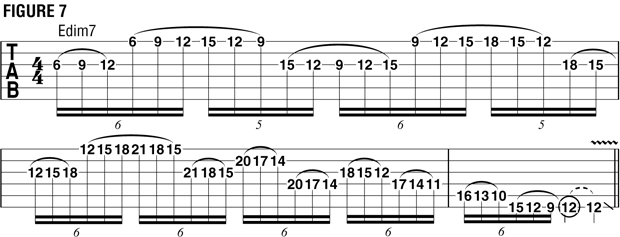Loud & Proud: Creating Alien Guitar Sounds by Combining Wide Stretches with Legato Techniques

When I was a kid, I used to love to listen to incredible guitarists like Shawn Lane, Rusty Cooley and Buckethead, all players that would simply amaze me with their mind-boggling speed and technical prowess.
For some of the really fast passages, I could hear that they were using a legato approach—incorporating an abundance of hammer-ons, pull-offs and finger slides—but I had absolutely no idea how to play the guitar in that way or achieve anywhere near their speed and precision. It sounded like nothing I’d ever heard before, so I always referred to it as “alien guitar.”
Later on, as my playing progressed, I figured out some of the techniques these players used and how to adopt those techniques into my own soloing.
In this column, I’d like to demonstrate a few of the fret-hand techniques and patterns I use that enable me to execute fast, fluid lines. I’ll be utilizing diminished-seven arpeggios in the key of E (E G Bb C#) as the musical structure upon which these riffs are built, with string-skipping being an integral part of the overall approach.


FIGURES 1 and 2 are played on the G and high E strings only, using a wide fret-hand stretch with the first, second and fourth fingers in order to fret notes at the ninth, 12th and 15th frets on both strings. In FIGURE 1, I begin by “rolling” up the G string with consecutive hammer-ons.
This “shape” shifts over to the high E string, and I follow the double-hammer-on with a double pull-off back down from the 15th to the 12th to the ninth frets. I then reverse the process back on the G string, starting with a double pull-off followed by a double hammer-on, in order to keep the riff rolling.
FIGURE 2 is essentially the same thing, except I initially play only one note on the high E string, return to the G string and then play the complete pattern illustrated in FIGURE 1. This approach breaks up the monotony of repeating the same movement on both strings.
The next logical step in the pursuit of “legato heaven” is to incorporate finger slides into the patterns.


In FIGURE 3, I begin in the same manner as FIGURE 1 but then slide up to the next higher position of Edim7 and then move back down to the G string. I slide up again when returning to the high E string as the line continues. FIGURE 4 offers the same pattern but in reverse.



In FIGURE 5, I move this idea over to the D and B strings. Notice the absolute symmetry between this line and the previous examples. FIGURES 6 and 7 offer a few more twists on how to expand on this approach.
Get The Pick Newsletter
All the latest guitar news, interviews, lessons, reviews, deals and more, direct to your inbox!
